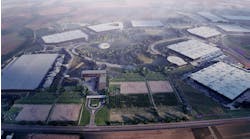When a manufacturing company controls the entire supply chain of its products from growing and processing the raw material to manufacturing the products and then delivering through direct and indirect sales, the supply chain takes center stage in determining factory location.
Consumer products manufacturer Amway, whose parent company, Alticor Inc., pulled in sales of $11.3 billion for 2012 and has seen with sales increases 12 out of the past 13 years, has made plans to accommodate its growth. Already underway is a $375 million investment in manufacturing and R&D expansion, including four facilities in the U.S., a new manufacturing facility in India and additional sites in both China and Vietnam.
Before deciding to build seven new plants over the next few years, the company had to analyze a myriad of factors, both consumer and non-consumer to determine the locations. “Looking at our costs we determined which costs were value added and which were not and for which products. There is no value add in paying duties or transportation costs, so manufacturing closer to the end customers makes sense. But there is value added in having our nutritional supplements, for example, made in the U.S. due to customer preference,” explains George Calvert, VP of Supply Chain/R&D.
The company manufactures products in fourteen categories including beauty, cosmetics, nutritional supplements, oral care, laundry, durable cooks and cookware. Therefore the impact of customer preference is vital. Amway can demand a premium in price from a supplement that is manufactured in the U.S., while there is no perceived value to a durable goods manufactured here, according to Calvert, which explains why that product line is manufactured overseas.
Non-U.S. sales have in fact become dominant in the company’s revenue mix. It now makes up 90% of the company’s total market. That's a change from the early days when Amway’s business was mostly in the U.S. In 2012 global markets that posted double digit increases include Columbia, Hong Kong, Italy, Mexico, Russia, Turkey and Venezuela.
One line of the company, its Nutrilite brand of high-end vitamins is growing and in fact has brought in records sales over the past six years. Four U.S. sites support that product line while current U.S. construction includes:
- A $24 million nutrition powder products plant at the company's world headquarters. The plant’s addition created 50 new jobs in Ada, Michigan.
- A $42 million project in Buena Park, California, includes a new granulation facility to support tablet manufacturing, new research and development facilities and pilot laboratories; and a two-story professional office building.
- A $38 million Nutrilite Botanical Concentrate processing plant in Quincy, Washington, which will process plants from the company's nearby Trout Lake Farm sites.
The Nutrilite line has also expanded in China whose overall country sales are at $4 billion. The company has two research and development centers in China and it now building a third one investing $10 million in a botanical research and experience center in Wuxi. The objective is to integrate scientific knowledge used in product development with the historic use of traditional Asian plants. “As China holds a great deal of knowledge about the medicinal botanicals we are locating at the source,” Calvert explains.
In Vietnam the company is also addressing the growth of the Nutrilite brand by investing $20 million in a new facility in Binh Duong . The plant, which will be completed in 2015, will also produce personal care products. The company also has a plant in the province of Dong Nai.
In India, which saw a 7% increase in sales last year from the previous year, Amway will build its first manufacturing plant in the country, breaking ground on a $95 million facility in Tamil Nadu later this year. Nutrition, beauty and personal care products will be manufactured at the site. India is now the seventh largest market for the company.
Part of the company’s success with its global strategy is its ability to be flexible. “As trade agreements continue to spur growth we, as should all companies, need to be flexible. A ten-year strategy could become obsolete in three years,” says Calvert.




